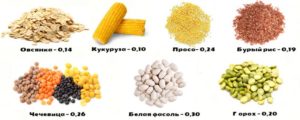Content
- 1 What is Phytic Acid
- 2 The health benefits of phytic acid
- 3 Why phytic acid is harmful
- 4 Products containing phytic acid
- 5
- 6 The rate of phytic acid in the diet
- 7 Phytase and phytic acid
- 8 How to neutralize phytic acid
- 9 Neutralizing phytic acid in oatmeal
- 10 The use of phytic acid in cosmetology and pharmaceuticals
- 11 Conclusion
People who watch their diet carefully study the composition of the product on the label. E391 can be seen on many products. This means that phytic acid is present in the composition. The benefits and harms of phytic acid, is it worth fearing and how to neutralize it - more on that later.
What is Phytic Acid
Phytic acid is a substance rich in phosphorus. This mineral is essential for the synthesis of energy, building the cell wall. It belongs to the group of anti-nutrients. This means that acid has the ability to bind nutrients in the digestive tract. They are absorbed in less quantities, which is harmful to the body.
In its pure form, it is a white powder, tasteless and odorless.
The health benefits of phytic acid
Although people are actively talking about the dangers of phytin for the body, it also has useful properties. When consumed in moderation, foods with this substance have the following beneficial effects:
- reduce the risk of developing tumors;
- contribute to the normal functioning of the endocrine system;
- prevent diseases of the heart and blood vessels by lowering the level of cholesterol and harmful lipoproteins in the blood;
- support the function of certain enzymes like vitamins;
- reduce the activity of free radicals, showing an antioxidant effect.
Based on the beneficial properties of phytin, researchers argue that there is no need to neutralize it. Acid neutralization is advisable if a person consumes foods with phytic acid in large quantities.
Why phytic acid is harmful
Phytin is only potentially harmful to health when consumed in excess of foods high in it. As an antinutrient, it contributes to the development of deficiencies of useful minerals and nutrients in the body. Most of all, the absorption of magnesium, phosphorus, zinc, copper, iron, calcium is disturbed.
The assimilation of proteins, fats and carbohydrates also suffers. A person does not receive those beneficial properties that they carry. This is due to the ability of phytic acid to inhibit the function of pepsin and trypsin, enzymes involved in the digestion of nutrients.
There is an opinion about the negative effect of phytic acid on the thyroid gland. It is believed that the substance has the property of disrupting the absorption of iodine. And this trace element is necessary for the normal production of thyroid hormones - thyroxine and triiodothyronine.
Although phytin is rich in phosphorus, it does not release it to the body. Therefore, it not only does not allow other microelements to be absorbed, but also does not share its own.
Products containing phytic acid
From the table about the content of phytic acid in foods, it can be seen that most of it is in legumes, grains, seeds and nuts. It is present in smaller quantities in root crops. Residues of the substance are found in fruits and vegetables.
|
Product |
The amount of phytic acid in% |
|
Potatoes |
0,2-0,3 |
|
Lentil grits |
0,45-0,5 |
|
Polished rice |
0,14-0,60 |
|
Hazelnut |
0,7 |
|
Walnut |
1,0 |
|
Peanut |
1,0-1,75 |
|
Almond |
1,5-3,4 |
|
Oats |
0,4-1,2 |
|
Soy |
1-2,3 |
|
Corn |
0,7-2,3 |
|
Wheat |
0,39-1,35 |
|
Linen |
2,0-2,9 |
|
Sesame |
5,5 |
|
Spinach |
0,3 |
The rate of phytic acid in the diet
Some states have their own daily dose of phytin. For Americans, it is considered normal to consume 630 mg per day, for the British - 760 mg, for Italians - 220 mg, for the Finns - 400 mg. That is, the average daily rate is 450-500 mg.
People who do not have problems with teeth, hair and health in general do not need to strictly calculate their phytin intake. It is enough just not to overuse cereals, nuts and legumes. But if there is a pathology, it is worth thinking about reducing the consumption of a harmful substance.
Phytase and phytic acid
Phytase is an enzyme needed to break down phytic acid and release phosphorus. Thanks to this enzyme, phosphorus becomes available for assimilation. In many animals, phytase is produced by the body.
This enzyme is also synthesized in the human stomach. But the amount is so minimal that it is sorely lacking to digest large amounts of phytin. In the mouse body, 50 times more enzyme is produced than in humans. Therefore, mice can constantly eat grains, unlike humans.
Least of all phytase is found in these products:

Phytase is a useful enzyme, but very fragile. It can be easily destroyed. Here are some factors that can neutralize the enzyme:
- cooking in water above 55-65 ° C or steam 80 ° C;
- freezing;
- long-term storage;
- grinding.
How to neutralize phytic acid
If a person often eats cereals, cereals, legumes, he should think about how to get rid of phytic acid. To neutralize substances in products, the following methods are used:
- soak;
- fermentation;
- germination;
- roasting;
- taking vitamin C.
Soak
Soaking cereals or legumes before eating is one of the most effective ways to eliminate the harmful substance. It allows you to get rid of 97% of the phytin they contain. The essence of the method is based on the activation of the enzyme phytase, which breaks down phytic acid.
Fermentation
Taking probiotics with lactobacilli significantly increases the bioavailability of trace elements. A good way is to make sourdough. The lactobacilli contained in it break down phytate complexes, promoting their absorption in the body.
Germination
A common way to get rid of phytic acid in cereals is by sprouting. Sprout soak without boiling is not as effective as boil steep or fermentation. It does not allow you to completely get rid of the substance, but significantly reduces its content in products. For legumes, 5 days of germination equals 60% neutralization of phytin.
The temperature at which germination takes place plays an important role. At a temperature of 30 ° C, you can get rid of twice as much acid as at 27 ° C.
Roasting
Frying is an easy way to halve the phytic acid content of nuts, cereals, and legumes. And if you soak or germinate the beans before roasting them, phytin is almost completely neutralized. In principle, thermal processing of food, whether boiling or frying, is the simplest and most effective way to eliminate excess harmful substances.
Taking vitamin C
Foods high in vitamin C have health benefits. They inhibit the action of phytic acid.

Neutralizing phytic acid in oatmeal
There are several ways to neutralize phytic acid in oatmeal. The first option is to soak the unheated oatmeal. These are sold in raw food stores. You need to soak for at least 12 hours. This method is not the most effective, since the phytinase produced is sufficient to neutralize only 25% of the phytin.
The second method is more effective. It consists of soaking regular oatmeal with whole grain flour. Thus, more than half of the phytin is eliminated. This is possible due to phytinase, which is found in large quantities in whole grain flour.
If you want to cook oatmeal, which will bring maximum benefit without harm to the body, you can use this recipe:
- Soak 60 g of dry oatmeal in 120 ml of warm water.
- Add 1 tbsp. l. whole grain flour and mix well.
- Add 1 tbsp. l. lemon juice and mix again.
- Soak the mixture for at least 12 hours.
- After this period, steam the mixture for 3-5 minutes over low heat.
This healthy oatmeal preparation method neutralizes nearly all phytic acid. And lemon juice, which contains vitamin C, will prevent phytin residues from being absorbed in the body.
The use of phytic acid in cosmetology and pharmaceuticals
While much has been said about the harmful properties of phytin, its topical use is beneficial. Therefore, it is widely used in cosmetology. Peeling with phytic acid corrects minor skin imperfections. The substance is not absorbed into the deep layers of the epithelium, therefore it does not harm the body. Phytic acid is suitable for such skin problems:
- acne;
- hyperpigmentation;
- thickening of the epidermis (hyperkeratosis);
- fine wrinkles;
- superficial scars and scars.
Phytin is used to produce several medications that are beneficial for liver and nervous tissue diseases.
Conclusion
The benefits and harms of phytic acid largely depend on the amount in which it enters the body. If its level does not exceed the daily rate, phytin will not be harmful. On the contrary, its useful properties are revealed in the prevention of the development of neoplasms, diseases of the heart and blood vessels. Neutralizing the substance is only advisable for people who over-consume foods high in phytin.

